Demantoid garnets are rare and radiant green gemstones from the andradite garnet family. Exceptional brilliance and fire characterize these gemstones. Their vibrant green color, often with a hint of gold, rival emeralds. This makes demantoid garnet a prized stone in high-end jewelry collections. The stone’s unique dispersion gives it a remarkable sparkle, adding to its allure. Whether in rings, earrings, or necklaces, demantoid garnet radiates pure luxury and elegance.
| Demantoid Garnet Asia Crystal Mineral Stone Healing |
|---|

|
| Click on the Image |
Table Of Contents And Brief Summary
|
|
Introduction to Demantoid Garnets.Discover the origins and basic properties of Demantoid Garnets, renowned for their brilliant fire and exceptional clarity.Go To Section: |
|
|
Characteristics of Demantoid Garnet.Explore the unique physical and optical characteristics that set Demantoid Garnets apart from other gemstones.Go To Section: |
|
|
Sources and Mining Locations.Learn about the primary regions where Demantoid Garnets are mined and the geological conditions that favor their formation.Go To Section: |
|
|
Grading and Valuation of Demantoid Garnet.Understand the grading criteria and factors that influence the valuation of Demantoid Garnets in the gemstone market.Go To Section: |
|
|
Uses of Demantoid Garnet in Jewelry.Explore the various applications of Demantoid Garnets in different types of jewelry, from rings to necklaces.Go To Section: |
|
|
Introduction to Demantoid Garnets.Back To Top |
Demantoid garnet ranks among the most prized and rare varieties of garnets. Its radiant green hue and remarkable brilliance make it stand out. As a type of andradite garnet, demantoid garnet dazzles with exceptional fire and sparkle. The name “demantoid,” which means “diamond-like” in Dutch, reflects this brilliance. Unlike other garnets, demantoids get their vibrant green color from trace amounts of chromium or iron. Discovered in Russia’s Ural Mountains during the 19th century, these gems became available from sources like Namibia and Madagascar, further enhancing their appeal.
|
|
What is Demantoid Garnet? |
A Coveted and Rare Gem in the Andradite Garnet Family:
Demantoid garnet, a rare and highly valued variety of andradite garnet, dazzles with its vibrant green color, often rivaling emeralds. Discovered in Russia’s Ural Mountains in the late 19th century, it quickly captivated mineralogists and jewelers. As one of the rarest varieties in the garnet group, natural demantoid garnets attract collectors and connoisseurs who seek out their exceptional beauty and rarity.
Distinctive Gemological Traits of Demantoid Garnets:
SUB-PARA 2) What sets Demantoid Garnet apart are its unique gemological characteristics. It boasts a high refractive index and remarkable dispersion, which give it a diamond-like luster and brilliance. In fact, its dispersion exceeds that of a diamond, resulting in a spectacular play of light and color within the stone. These properties make it one of the most valuable garnets among green garnets and rare gemstones.
Fascinating Origin Of The Gems Name:
The name “Demantoid” is derived from the Dutch word “demant,” meaning diamond, highlighting its exceptional brilliance and sparkle. This etymology reflects the gemstone’s diamond-like qualities that have fascinated gem enthusiasts since its discovery. Russian demantoid garnets, in particular, are highly prized for their rich green hues and are considered some of the most valuable garnets available.
| Natural Demantoid Garnet 1.17 carats set in Platinum Ring with 0.38 carats Diamonds |
|---|
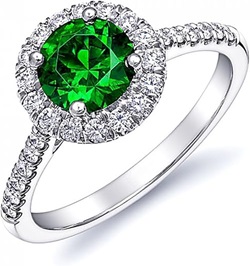
|
| Click on the Image |
|
|
Why Are Demantoid Garnets Considered Luxury Gems? |
Exceptional Rarity and Limited Availability.
Demantoid Garnet is considered a luxury gem chiefly because of its exceptional rarity and limited availability. Unlike more common gemstones, Demantoid Garnets are found in only a handful of locations worldwide, with the most prized specimens originating from the Ural Mountains in Russia. This scarcity elevates the gemstone’s status, making it a coveted collector’s gemstone among enthusiasts and connoisseurs. The limited supply ensures that Demantoid Garnets remain exclusive, driving up their investment value and solidifying their position in high-end jewelry markets.
Exceptional Brilliance and Fire.
Another factor contributing to its luxury status is the gemstone’s exceptional brilliance and fire. Demantoid Garnets possess a high refractive index and remarkable dispersion, surpassing even that of diamonds. This means they exhibit an extraordinary play of light and color, known as fire, which adds to their allure. Such optical excellence makes them stand out in any jewelry piece, appealing to those who appreciate gemstones with unparalleled visual properties. Their exceptional brilliance enhances their desirability, further cementing their reputation as a luxury gem.
High Demand Among Collectors and Investors.
The combination of rarity and exceptional optical qualities has led to a high demand among collectors and investors. Demantoid Garnets are not just gemstones; they are investment assets that can appreciate over time. Their limited availability and exceptional beauty make them a wise addition to any investment portfolio focused on rare gemstones. This high demand drives their market value upward, making them a symbol of luxury and exclusivity in the gemstone industry.
|
|
Historical Significance and Discovery Of Gemstone Demantoids |
Discovery in the Ural Mountains.
Demantoid Garnets were first discovered in the early 19th century in the Ural Mountains of Russia. This region, rich in mineral resources, unveiled these captivating green gemstones to the world. The initial find sparked considerable interest among mineralogists and gem enthusiasts, as the gemstones exhibited a vibrant green hue unlike any other garnet varieties known at the time. The Ural Mountains quickly became the primary source of Demantoid Garnets, contributing significantly to Russia’s prominence in the gemstone market.
Popularity During the Tsarist Era and Victorian Jewelry.
During the Tsarist era, Demantoid Garnets gained immense popularity among the Russian aristocracy. The gemstone’s exceptional brilliance and unique coloration made it a favored choice for high-end jewelry commissioned by the nobility. Its allure extended beyond Russia’s borders, capturing the fascination of European jewelers during the Victorian period. Demantoid Garnets were incorporated into intricate Victorian jewelry designs, often set in platinum and gold and adorned with diamonds and other precious stones. This cross-cultural appreciation elevated the gemstone’s status and solidified it as a luxury gem in historical contexts.
Contributions of Notable Gemologists and Jewelers.
The works of famous gemologists and jewelers of the time further amplified the fame of Demantoid Garnets. Notably, Peter Carl Fabergé, the renowned Russian jeweler, incorporated Demantoid Garnets into his exquisite creations, including the iconic Fabergé eggs. His use of the gemstone showcased its versatility and enhanced its desirability among the elite, particularly the rare Russian demantoids. Additionally, George Frederick Kunz, an American mineralogist and gemologist, studied Demantoid Garnets extensively, contributing to the scientific understanding and appreciation of this rare gemstone. These contributions by prominent figures in the gemstone industry played a significant role in cementing the historical significance of Demantoid Garnets.
| Demantoid Garnet White Diamond Oval 18K White Chunky Solid Real Gold Jewelry Dangle Drop Earrings |
|---|
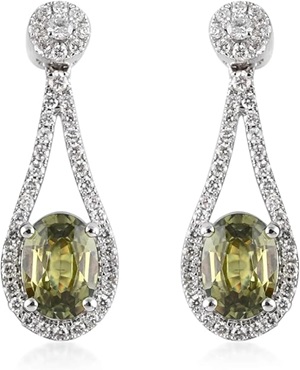
|
| Click on the Image |
|
|
Characteristics of Demantoid Garnet.Back To Top |
Demantoid garnets are known for their intense green color, ranging from a vibrant emerald-like hue to a softer yellow-green. These gems are famous for their high refractive index, producing exceptional brilliance and fire that often surpasses diamonds. One of the standout features is their remarkable dispersion, creating a rainbow-like play of light within the stone. Additionally, Russian demantoid garnets often contain unique “horsetail” inclusions. These are fine needle-like patterns that increase their value among collectors. This combination of rarity, brilliance, and unique internal characteristics makes demantoid garnets (particularly those from Russia in the early 19th century) highly sought after.
|
|
What Gives Demantoid Garnet its Unique Green Color? |
The Role of Chromium and Iron in Gemstone Chemistry.
Demantoid Garnet’s captivating deep green coloration is primarily due to the presence of chromium and iron within its crystal structure. The gemstone’s green body emerges from this unique combination of elements. Chromium content is chiefly responsible for the vibrant green hues, infusing the stone with a rich and intense color. Iron impurities also play a significant role, subtly influencing the depth and shade of the green coloration. This interplay of chromium and iron is what gives demantoid its green and sets it apart in the world of gemstones.
Variations in Green Shades.
The varying proportions of chromium and iron lead to a spectrum of green shades in Demantoid Garnets. Higher concentrations of chromium result in a more intense deep green, while increased iron content can introduce yellowish or brownish undertones to the green coloration. These color variations, including the vibrant yellowish green, make each demantoid unique, adding to its appeal among collectors and enthusiasts. The natural coloration achieved through this elemental balance is a testament to the intricate processes that occur within the Earth over millions of years.
Influence of Horsetail Inclusions on Color Perception.
A distinctive feature of many Demantoid Garnets is the presence of “horse-tail” inclusions—fine, fibrous formations of the mineral byssolite that resemble the shape of the tail of a horse. These inclusions are not merely identifying marks of natural demantoid garnets but also contribute to the gemstone’s overall visual effect. The horse-tail inclusions can enhance the gemstone’s brilliance by scattering light within the stone, which can subtly affect the perception of its green coloration. In some cases, these inclusions add a silky sheen or internal radiance that amplifies the gem’s deep green allure, making it even more sought after in high-end jewelry markets.
| Diamond Natural Garnet Halo Engagement Ring in 18K Yellow Gold |
|---|
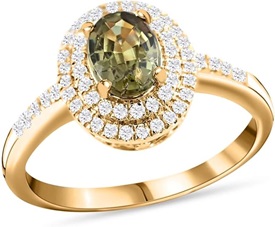
|
| Click on the Image |
|
|
Physical and Chemical Properties |
Hardness on the Mohs Scale.
Demantoid Garnet exhibits a hardness ranging from 6.5 to 7 on the Mohs hardness scale. This level of hardness indicates that while it is relatively durable, it is softer than gemstones like sapphire or diamond. Consequently, Demantoid Garnets require careful handling to prevent scratches or abrasions. Their placement in jewelry, especially in pieces like rings that are subject to daily wear, should consider this hardness factor to maintain the gemstone’s integrity over time.
Refractive Index and Optical Properties.
One of the most remarkable optical properties of Demantoid Garnet is its high refractive index, measured between 1.880 and 1.889. This high refractive index contributes significantly to the gemstone’s exceptional brilliance and luster. Additionally, Demantoid Garnets possess a strong dispersion of light, often referred to as “fire,” which exceeds even that of diamonds. This dispersion of demantoid results in a vivid play of spectral colors when light passes through the gemstone, enhancing its visual appeal and making it a standout choice in fine jewelry.
Chemical Composition and Crystal Structure.
Chemically, Demantoid Garnet is a calcium iron silicate with the formula Ca_3Fe_2(SiO_4)_3. This composition places it within the andradite group of garnets. The presence of iron within its crystal structure is integral to its chemical properties and contributes to its overall stability. The crystal structure of Demantoid Garnet is isometric, meaning it crystallizes in the cubic crystal system. This structure accounts for its excellent cleavage and contributes to its overall thermal stability, making it suitable for various types of gemstone cutting and setting.
Thermal Stability and Durability.
In terms of thermal stability, Demantoid Garnets are relatively stable but can be sensitive to sudden temperature changes, especially the largest demantoid specimens or those with significant inclusions. Extreme heat can potentially alter their color or cause fractures within the crystal structure. Therefore, it’s advisable to avoid exposing the gemstone to high temperatures or abrupt thermal fluctuations. Understanding these physical and chemical properties is essential for proper care and maintenance, ensuring that the gemstone retains its beauty and structural integrity over time.
| Natural Garnet Solitaire Engagement Ring for Women in 18K Yellow Chunky Solid Real Gold |
|---|
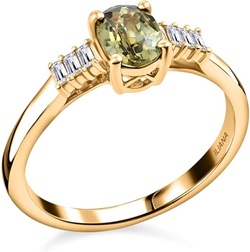
|
| Click on the Image |
|
|
What Makes These Green Garnets Different from Other Garnets? |
Unique Color Spectrum and Rarity Among Garnets.
Demantoid Garnet distinguishes itself from other garnet group minerals through its exceptional green color spectrum, ranging from a vivid emerald green to a radiant yellowish-green. While garnets are commonly associated with red hues, Demantoid’s green coloration is a rare phenomenon within the garnet family. This rarity among garnets not only makes it highly sought after but also significantly increases its value in the gemstone market. Its scarcity and distinctive color set it apart as one of the most coveted and valuable garnet varieties available today.
Exceptional Brilliance and Dispersion Rates.
Another defining characteristic of Demantoid Garnet is its remarkable optical and physical properties, particularly its high dispersion rates. Dispersion refers to a gemstone’s ability to split light into its constituent spectral colors, creating a dazzling display of “fire” within the stone. Demantoid Garnets display substantially more fire than other garnet varieties and even surpass diamonds in this regard. This exceptional brilliance and play of light contribute to the gemstone’s allure, making it stand out in any jewelry piece, especially when compared to the less brilliant green dragon variety.
Presence of “Horse-Tail” Inclusions.
A unique feature that sets Demantoid Garnet apart is the presence of “horse-tail” inclusions. These are slender, radiating fibers of the mineral byssolite that resemble the flowing tail of a horse. Unlike inclusions in other gemstones, which are often viewed as imperfections, these unique inclusions are highly prized in Demantoid Garnets. They are considered a hallmark of authenticity, particularly in stones originating from the Ural Mountains in Russia. The “horse-tail” inclusions not only enhance the gemstone’s natural beauty but also add to its rarity and value, further distinguishing it from other members of the garnet family.
| Demantoid Garnet Moissanite 925 Sterling Silver Vermeil Yellow Gold Plated Hoops Hoop Earrings |
|---|
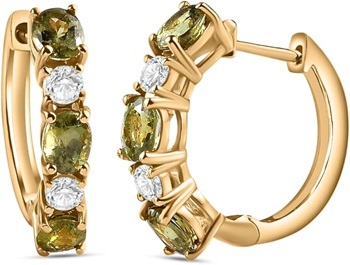
|
| Click on the Image |
|
|
Sources and Mining Locations.Back To Top |
Demantoid garnets are primarily sourced from a few key regions. The Ural Mountains in Russia are known for producing top-quality gems with “horse-tail” inclusions, while Namibia yields vibrant, inclusion-free stones. Italy, especially the Val Malenco area, also contributes to global supply, along with emerging sources in Iran and Madagascar. Despite these locations, demantoid garnets remain rare and exclusive, adding to their allure in the gemstone market.
|
|
Where Are the Major Sources of Demantoid Garnet? |
Russian Deposits: The Ural Mountains.
The original and most significant deposits of demantoid garnet are in Russia, particularly in the Ural Mountains. Discovered in the mid-19th century, these mining regions have produced some of the finest garnet from Russia. The stones from this area are famous for their vivid green hues and the distinctive “horse-tail” inclusions, which are highly prized by collectors and jewelers. Russian czars favored these gems, further enhancing their reputation. Mining in Russia has played a crucial role in establishing the country as the primary source for this rare gemstone, with deposits in Russia continuing to supply the global market with high-quality demantoid garnets.
Namibian Mines.
In recent decades, deposits in Namibia have become a significant source of demantoid garnets. The Namibian mines, located in the Erongo Region, produce larger and cleaner gemstones compared to those from Russia. While Namibian demantoid garnets typically lack the classic “horse-tail” inclusions found in Russian stones, they boast a vibrant green color and excellent clarity. These deposits of demantoid garnets have expanded the gemstone’s availability globally, providing an alternative to the traditional garnet from Russia, and further diversifying the market.
Italian Sources.
Italy has also contributed to the global distribution of variety demantoid garnets, with deposits primarily located in the Val Malenco region of Lombardy. Although smaller in scale compared to Russia and Namibia, Italian deposits offer unique jewelry stones with varying shades of green and occasional inclusions. These sources have been active since the late 20th century, providing collectors and jewelers with a different take on this exquisite stone
Emerging Mining Regions.
Newer deposits of demantoid garnets have been discovered in places like Madagascar and Iran. These emerging regions offer gemstones with bright green colors and impressive clarity. As mining operations in these areas continue to grow, they are beginning to impact the global market. Although still in development, these regions are gradually expanding the options for consumers, affecting both the availability and pricing of this rare gem.
| 14K White Gold 0.73ct TGW Demantoid Garnet and White Diamonds Ring |
|---|
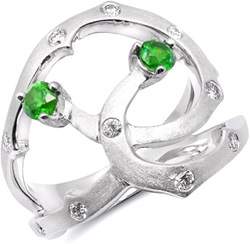
|
| Click on the Image |
|
|
How is Demantoid Garnet Mined? |
Mining Techniques: Alluvial and Hard-Rock Mining.
Demantoid garnets are extracted using two main techniques: alluvial and hard-rock mining. Alluvial mining involves searching riverbeds and sedimentary deposits, where natural forces have washed garnets from their original rock formations. Miners use simple tools like shovels and sieves to sift through the deposits, making it a labor-intensive process. While mining demantoid garnets can be relatively efficient once the deposits are located, it remains a challenging task, especially in areas known for green yttrium aluminum garnet.
Hard-rock mining, on the other hand, requires drilling and blasting to access garnets embedded in solid rock. This more complex technique uses heavy machinery and skilled labor to break down host rocks and extract the gemstones. While more expensive, hard-rock mining often yields higher-quality stones from gem-rich veins that alluvial methods can’t reach.
Geological Challenges in Extraction.
Extracting demantoid garnets poses unique challenges due to their geological settings. These gems are often located in remote, rugged areas, complicating access. Their host rocks can be irregular and discontinuous, requiring careful exploration and handling. Additionally, balancing efficient extraction with environmental preservation is crucial. Mining operations must minimize their impact by managing waste, preventing water contamination, and rehabilitating mined land.
Role of Artisanal Miners in the Supply Chain.
Artisanal miners play a key role in the supply of demantoid garnets, especially in regions where large-scale mining is impractical. These local miners use traditional, manual methods to extract gemstones from alluvial deposits, often yielding the prized demantoids with horsetail inclusions. Their work supports local economies and keeps traditional practices alive. However, concerns over labor conditions, fair compensation, and environmental impact exist. Initiatives are being developed to ensure artisanal miners are ethically recognized and integrated into sustainable sourcing practices.
| 14k White Gold 0.77ct TGW Russian Demantoid Garnet and White Diamond Ring |
|---|
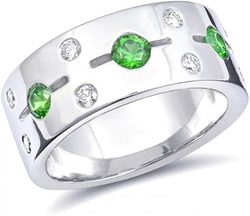
|
| Click on the Image |
|
|
Grading and Valuation of Demantoid Garnet.Back To Top |
The grading of Demantoid Garnets is based on the traditional “4 Cs” used in gemstones: color, clarity, cut, and carat weight. Color intensity is the most critical factor, with the most valuable stones exhibiting a vibrant green hue without any secondary yellow or brown tones. Clarity grades assess the presence of inclusions; while some inclusions like the “horse-tail” can add value, excessive inclusions may diminish the gemstone’s brilliance. The cut quality influences how well the stone reflects light, enhancing its optical properties and overall appeal.
|
|
How is Demantoid Garnet Graded? |
Grading Based on the 4 Cs of Gemstones.
Demantoid Garnets are evaluated using the traditional 4 Cs of gemstones: color, clarity, cut, and carat weight. Each factor plays a vital role in determining the gemstone’s quality and value.
Color:
The most critical aspect is the color intensity of the gemstone. Stones with an intense green coloration are highly prized. The ideal Demantoid Garnet exhibits a vivid green hue without any yellow or brown undertones. Stones with more intense green are considered superior and command higher prices. Uniformity of color throughout the stone enhances its overall appeal and is a key factor in grading.
Clarity:
This attribute assesses the presence of inclusions or imperfections within the gemstone. While some inclusions, like the unique “horse-tail” fibers, can add character and even increase value, excessive inclusions may detract from the stone’s brilliance. High-clarity Demantoid Garnets with minimal visible inclusions are more desirable in the market.
Cut Quality:
The cut quality influences how well the gemstone interacts with light. A well-cut Demantoid Garnet maximizes its brilliance and showcases its exceptional dispersion. Precision in cutting brings out the stone’s natural beauty, enhancing its optical properties and making it more attractive to buyers.
Carat Weight:
It refers to the size of the gemstone. Demantoid Garnets are typically found in smaller sizes, and stones exceeding two carats are very rare. Larger stones with excellent color and clarity are exceptionally valuable due to their scarcity. However, a smaller stone with superior color and cut may be more valuable than a larger one of lesser quality.
Significance of Color Intensity and Uniformity.
The intense green coloration of Demantoid Garnets is a primary determinant of their value. Uniform and vivid green tones without zoning or color variations are most sought after. The presence of chromium contributes to the stone’s vibrant color, and the depth of this hue significantly impacts the gemstone’s grading. Collectors highly prize stones with a deep, consistent green, as they represent the finest quality available.
The Role of Gemstone Certification.
Obtaining a certification from a recognized gemological laboratory is crucial when assessing a Demantoid Garnet. Certification provides an official verification of the gemstone’s authenticity and details its characteristics, including color, clarity, cut, and carat weight. Reputable organizations like the Gemological Institute of America (GIA) offer comprehensive reports that assure buyers of the stone’s quality, especially for those interested in Russian demantoids. Certification not only instills confidence in the purchase but also can enhance the gemstone’s value, especially for investment purposes. It is an essential step for anyone looking to acquire high-quality Demantoid Garnets.
| 14k White Gold 0.82ct TGW Demantoid Garnet and White Diamond Ring |
|---|
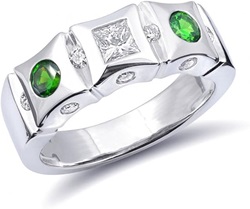
|
| Click on the Image |
|
|
Factors Influencing the Value of Demantoid Garnet |
Rarity and Demand.
The value of Demantoid Garnets is profoundly affected by their rarity and demand in the gemstone market. As one of the rarest varieties in the garnet group, high-quality Demantoid Garnets are scarce, making them highly sought after by collectors and enthusiasts. This limited availability elevates their desirability, and as demand outpaces supply, prices naturally increase. Market trends consistently show that exceptional specimens fetch premium prices at auctions and in retail settings, reflecting their status as a coveted luxury item.
Presence of Unique Inclusions.
The presence of inclusions, particularly the distinctive “horse-tail” inclusions, plays a significant role in influencing the gemstone’s value. Unlike typical inclusions that might diminish a gemstone’s worth, these unique byssolite fibers are considered highly desirable in Demantoid Garnets. The “horse-tail” inclusions not only authenticate the gemstone’s natural origin but also enhance its aesthetic appeal. Stones exhibiting well-defined and attractive inclusions are often more valuable, as they are rare and add a unique character to each gemstone.
Origin of the Gemstone.
The origin of the gemstone is a crucial factor in its valuation. Demantoid Garnets from the Ural Mountains in Russia are particularly esteemed due to their historical significance and superior quality. Russian stones are renowned for their vibrant green color and the presence of the coveted “horse-tail” inclusions. As a result, they often command higher prices compared to those from other locations. While Demantoid Garnets from Namibia, Italy, and emerging sources contribute to the global supply, stones from these regions may vary in color intensity and inclusion features, affecting their market value.
Size and Weight.
The value of Demantoid Garnets is heavily impacted by their size and weight. Larger stones are exceedingly rare, and as a result, the price per carat increases substantially with size. Gemstones exceeding two carats are considered exceptional and are highly prized by collectors. However, it’s important to note that quality should not be sacrificed for size. A smaller Demantoid Garnet with intense color and excellent clarity can be more valuable than a larger stone with inferior characteristics. The balance between size, color intensity, and clarity determines the gemstone’s overall worth.
Market Trends.
Current market trends indicate a growing appreciation for Demantoid Garnets, driven by their rarity and unique features. As awareness of these gemstones increases, so does the demand, particularly in markets that value exclusive and distinctive gems. Investment in Demantoid Garnets is favorable due to their potential for value appreciation. Collectors are particularly interested in stones with verified origins, unique inclusions, and exceptional quality, all of which contribute to their enduring market appeal.
|
|
Uses of Demantoid Garnet in Jewelry.Back To Top |
Demantoid Garnets are treasured by jewelry enthusiasts for their vibrant green color and brilliance, making them ideal for high-end jewelry like engagement rings, necklaces, and earrings. Their unique hues lend themselves to standout designs in both contemporary and vintage collections.
Demantoid Garnets are popular in men’s jewelry and are featured in cufflinks, rings, and tie pins. Their rich green tones add sophistication and align with modern gemstone trends.
These versatile gems can be set in platinum, white, or yellow gold. Jewelers often pair them with diamonds or other precious stones to enhance their fire and brilliance in various settings.
|
|
Popular Jewelry Designs Featuring Demantoid Garnet |
A Unique Choice for Engagement Rings.
Demantoid Garnet, with its intense green color and rarity, has become a favorite alternative to diamonds in engagement rings. Couples are drawn to the gem’s symbolic meaning of prosperity and renewal, making it a meaningful choice for these special pieces. Whether set as a solitaire or accented with diamonds, Demantoid Garnet engagement rings create a distinctive, luxurious look.
Reviving Vintage Designs with Demantoid Garnet.
This gemstone was popular during the late 19th and early 20th centuries, especially in Art Nouveau jewelry. Its vibrant green hue was used to emulate natural forms like leaves and vines. Today, vintage-inspired designs featuring Demantoid Garnet are making a comeback, attracting those who love the blend of history and artistry.
Showcasing Brilliance in Necklaces and Earrings.
Demantoid Garnet’s exceptional brilliance and high dispersion make it a standout choice for necklaces and earrings. Designers experiment with different cuts and settings to enhance its ability to catch and reflect light, creating pieces that are both modern and timeless.
Pairing Demantoid Garnet with Complementary Metals.
This versatile gemstone pairs beautifully with a range of metals. Platinum enhances the cool undertones of demantoids, while yellow gold adds a warm contrast that complements their yellowish green hue. Rose gold provides a romantic flair, offering unique options for personalized designs.
Bespoke Jewelry Creations with Demantoid Garnet.
Jewelers often create custom settings for Demantoid Garnet, from intricate details to minimalist designs. This bespoke approach ensures that each piece is unique, reflecting both the wearer’s personality and the gemstone’s exclusivity.
The Enduring Allure of Demantoid Garnet.
Demantoid Garnet continues to captivate designers and consumers alike. Its beauty and rarity, combined with its use in various jewelry designs, secure its status as a gemstone of luxury and distinction.
|
|
Care and Maintenance of Demantoid Garnet Jewelry |
Cleaning Methods.
Proper care of your Demantoid Garnet jewelry begins with regular cleaning to maintain its exceptional brilliance and vibrant green hue. To clean the gemstone safely, use mild soap and lukewarm water. Gently scrub the jewelry with a soft brush, such as a toothbrush with soft bristles, to remove any dirt or oils that may have accumulated. Avoid using harsh chemicals or abrasive cleaners, as they can damage the gemstone’s surface and diminish its luster. After cleaning, rinse the jewelry thoroughly with clean water and pat it dry with a soft, lint-free cloth to prevent water spots.
Storage Tips.
Storing your Demantoid Garnet jewelry properly is essential to prevent scratches and other forms of damage. Keep each piece in a separate, soft-lined jewelry box or pouch to avoid contact with other gemstones and metals that could scratch the surface. If you have multiple pieces, consider wrapping them individually in anti-tarnish cloths. Store the jewelry in a cool, dry place away from direct sunlight, as prolonged exposure to heat and light can potentially affect the gemstone’s color and structural integrity. These storage tips will help preserve the beauty and longevity of your Demantoid Garnet pieces.
Professional Check-ups and Longevity of the Gemstone.
Regular professional inspections are recommended to maintain the condition of your Demantoid Garnet jewelry. A qualified jeweler can check for loose settings, signs of wear, and other issues that may not be immediately apparent. Scheduling professional check-ups at least once a year ensures that any necessary repairs or adjustments are made promptly, safeguarding your investment. Additionally, professional cleanings can enhance the gemstone’s brilliance beyond what at-home methods can achieve. By following these care practices, you can enjoy the enduring beauty and longevity of your Demantoid Garnet jewelry for years to come.
See More Gemstones As Follows